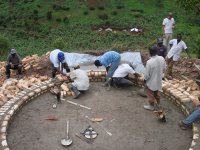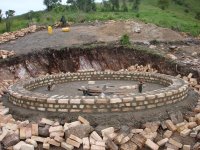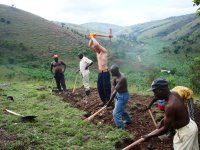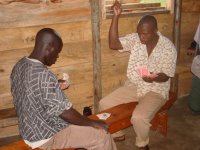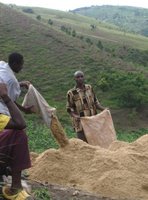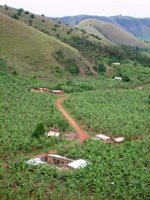Lake Bunyonyi Rainwater Catchment
I spent one week at another ACTS project site collecting data to write a project proposal for rainwater catchment for communities in the hills that have a very long hike to get water from the lake. Some of the longest water treks is 4 hours return. I estimated about a 500m elevation gain for the highest communities. This is quite a hike with a 20L jerry can of water.
Lake Bunyonyi is a large lake outside the city of Kabale in the southwest corner of Uganda. It is about 2000m elevation and one of the few lakes in Africa that has no parasites and therefore it can be swam in. ACTS started an eco-tourism camp on Bushara Island here about 15 years ago and formed the Lake Bunyonyi Development Co. (LBDC) which is independant of ACTS. ACTS is not involved in the tourist camp anymore but still sends two interns to work in the surrounding communities with health and agriculture. They live on the island. It seems like water shouldnt be a problem in this area but some communities are a surprisingly long way from water. Luckily, the area has the second highest rainfall in the country, around 1,000mm a year. Overall I think I visited 14 communities in which 38 catchments were proposed. It was more than I had expected. I think the project, if completed all at once, would cost like $60,000 or $70,000 Canadian.
 At the Lake Bunyonyi dock on arrival
At the Lake Bunyonyi dock on arrival
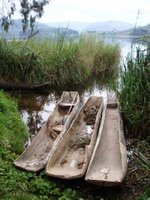 A few dugout canoes on Bushara Island
A few dugout canoes on Bushara Island
 A lady with ACTS who is here for two months gave 25 goats to locals in this community
A lady with ACTS who is here for two months gave 25 goats to locals in this community
 After the goat giving, an orphan group supported by the LBDC performed for us
After the goat giving, an orphan group supported by the LBDC performed for us
 A view south. The dirt road leads to Rwanda and the hills in the back of the picture are in Rwanda
A view south. The dirt road leads to Rwanda and the hills in the back of the picture are in Rwanda
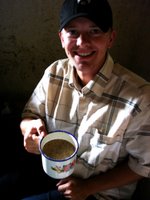 After church (yes I sometimes have to go to church, its work related) we were taken into a dark room where we had lunch and then started drinking this strange brew called sogrum poridge. I dont know much about it but it takes like a bad batch of u-brew, has a lot of grain in it, and is somewhat alcoholic
After church (yes I sometimes have to go to church, its work related) we were taken into a dark room where we had lunch and then started drinking this strange brew called sogrum poridge. I dont know much about it but it takes like a bad batch of u-brew, has a lot of grain in it, and is somewhat alcoholic
 Dugout canoes are the primary mode of transport on the lake
Dugout canoes are the primary mode of transport on the lake
 A view of the lake from one of the communities we visited.
A view of the lake from one of the communities we visited.
 The girls have a rope swing near their house on Bushara Island
The girls have a rope swing near their house on Bushara Island
 The kids in this community were especially crazy. I dont think theyd had any white people in the community before because to get there was a boat ride followed by an 1.5 hour hike.
The kids in this community were especially crazy. I dont think theyd had any white people in the community before because to get there was a boat ride followed by an 1.5 hour hike.
 Rain over Lake Bunyonyi, from one of the highest communities
Rain over Lake Bunyonyi, from one of the highest communities
 Heavy rain on my last day in Kabale. The roads were all flooding. I saw a guy on a bike get completely soaked by the wake of a car, which myself and several locals on the sidewalk had a good laugh at.
Heavy rain on my last day in Kabale. The roads were all flooding. I saw a guy on a bike get completely soaked by the wake of a car, which myself and several locals on the sidewalk had a good laugh at.
Lake Bunyonyi is a large lake outside the city of Kabale in the southwest corner of Uganda. It is about 2000m elevation and one of the few lakes in Africa that has no parasites and therefore it can be swam in. ACTS started an eco-tourism camp on Bushara Island here about 15 years ago and formed the Lake Bunyonyi Development Co. (LBDC) which is independant of ACTS. ACTS is not involved in the tourist camp anymore but still sends two interns to work in the surrounding communities with health and agriculture. They live on the island. It seems like water shouldnt be a problem in this area but some communities are a surprisingly long way from water. Luckily, the area has the second highest rainfall in the country, around 1,000mm a year. Overall I think I visited 14 communities in which 38 catchments were proposed. It was more than I had expected. I think the project, if completed all at once, would cost like $60,000 or $70,000 Canadian.
 At the Lake Bunyonyi dock on arrival
At the Lake Bunyonyi dock on arrival A few dugout canoes on Bushara Island
A few dugout canoes on Bushara Island A lady with ACTS who is here for two months gave 25 goats to locals in this community
A lady with ACTS who is here for two months gave 25 goats to locals in this community After the goat giving, an orphan group supported by the LBDC performed for us
After the goat giving, an orphan group supported by the LBDC performed for us A view south. The dirt road leads to Rwanda and the hills in the back of the picture are in Rwanda
A view south. The dirt road leads to Rwanda and the hills in the back of the picture are in Rwanda After church (yes I sometimes have to go to church, its work related) we were taken into a dark room where we had lunch and then started drinking this strange brew called sogrum poridge. I dont know much about it but it takes like a bad batch of u-brew, has a lot of grain in it, and is somewhat alcoholic
After church (yes I sometimes have to go to church, its work related) we were taken into a dark room where we had lunch and then started drinking this strange brew called sogrum poridge. I dont know much about it but it takes like a bad batch of u-brew, has a lot of grain in it, and is somewhat alcoholic Dugout canoes are the primary mode of transport on the lake
Dugout canoes are the primary mode of transport on the lake A view of the lake from one of the communities we visited.
A view of the lake from one of the communities we visited. The girls have a rope swing near their house on Bushara Island
The girls have a rope swing near their house on Bushara Island The kids in this community were especially crazy. I dont think theyd had any white people in the community before because to get there was a boat ride followed by an 1.5 hour hike.
The kids in this community were especially crazy. I dont think theyd had any white people in the community before because to get there was a boat ride followed by an 1.5 hour hike. Rain over Lake Bunyonyi, from one of the highest communities
Rain over Lake Bunyonyi, from one of the highest communities Heavy rain on my last day in Kabale. The roads were all flooding. I saw a guy on a bike get completely soaked by the wake of a car, which myself and several locals on the sidewalk had a good laugh at.
Heavy rain on my last day in Kabale. The roads were all flooding. I saw a guy on a bike get completely soaked by the wake of a car, which myself and several locals on the sidewalk had a good laugh at.








